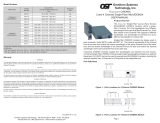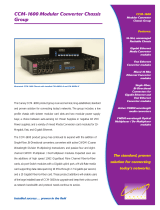Page is loading ...

FiberPlex™TD-OADM Series
Optical Add/Drop Multiplexer
User Manual
Part Number: 07MTD-OADM-UM, Rev. B
Revised: October 24, 2018
Sales Office: +1 (301) 975-1000
Technical Support: +1 (301) 975-1007
E-mail: support@patton.com
WWW: www.patton.com

2 FiberPlex TD-OADM User Manual
1.0 Introduction
Figure 1. FiberPlex TD-OADM (Dust Covers Removed)
The FiberPlex TD-OADM (see figure 1) is a coarse wave division multiplexing (CWDM)
optical add/drop multiplexer (OADM) used in wavelength division multiplexing (WDM)
systems for multiplexing and routing different channels of light into or out of a single
mode fiber (SMF). A dedicated wavelength is assigned to any kind of voice, video or
network traffic. The TD-OADM adds (multiplexes) and drops (demultiplexes) selected
channels, or wavelengths, on West and East directions of a CWDM fiber link.
These channels are completely transparent to traffic type, protocols, and compression
schemes. TD-OADMs are often used in point-to-point, linear, ring, star, and mesh topol-
ogies for a large variety of applications (see figure 2 on page 3).
Do not install near any heat sources such as radiators, heat
registers, stoves, or other apparatus (including amplifiers)
that produce heat.
• Clean device with a dry cloth only.
• Read these instructions.
• Follow all instructions.
• Keep these instructions.
CAUTION
IMPORTANT

FiberPlex TD-OADM User Manual 3
Figure 2. Typical application
1.1 Key features
Primary applications:
• Metro area networks
• Mobile fronthaul/backhaul
• AV distribution
• Large enterprise
• Intra-SCIF (sensitive compartmented information facility) distribution
Wavelength: Full ITU-T G.694.2 spectrum grid support (1270 to 1610 nm)
Isolation: East/West operation with 2 x TX/RX connections for center wavelength
Power: Completely passive operation that requires no external power
Extended Temperature: 23 to 149°F (-5 to 65°C)
1.2 Drop Ports (West and East)
The Drop ports (see figure 3) transmit (TX) signals on a specific CWDM wavelength.
Drop ports are demultiplexed from the fullband (West/East) ports. As shown in

4 FiberPlex TD-OADM User Manual
figure 4, a 1-channel TD-OADM supports a single channel in West and East directions.
Each Drop port has a West and East port. Data transmitted by the West Drop port is
split from the West fullband port, and data transmitted by East Drop port is split from
the East fullband port. Data on the designated wavelength is blocked from passing
through the fullband ports.
Figure 3.
TD-OADM Ports and Wavelength Label
1.3 Add Ports (West and East)
The Add ports (see figure 3) receive (RX) signals on a specific CWDM wavelength. Add
ports are multiplexed on the fullband (West/East) ports. As shown in figure 4, a 1-
channel TD-OADM supports a single channel in West and East directions. Each Add
port has a West and East port. Data received by the West Add port is aggregated on the
West fullband port, and data received by East Add port is aggregated on the East full-
band port. The Add data at the designated wavelength overwrites the data on that wave-
length in the fullband ports.
Figure 4.
1-Channel Add/Drop Multiplex/Demultiplex

FiberPlex TD-OADM User Manual 5
1.4 Fullband Ports (West and East)
Fullband ports (see figure 3 on page 4) transmit (TX) and receive (RX) the aggregated
wavelengths connected to the Drop/Add ports. As shown in figure 4 on page 4, there
are West and East fullband ports on the TD-OADM. The West fullband port and the East
fullband port are internally connected so as to pass all wavelengths that are not in the
TD-OADM’s specific wavelength. Only the TD-OADM’s specific wavelength will be
dropped from the appropriate Drop port or added to the appropriate Add port. The West
fullband Drop and Add ports drop and add wavelength traffic from the West Drop and
Add ports, and the East fullband Drop and Add ports drop and add wavelength traffic
from the East Drop and Add ports.
2.0 Installation
Note Verify that the wavelength label on the TD-OADM (see figure 3 on page 4)
matches the wavelength of the attached device.
Note For proper installation, a network diagram indicating port designations is recom-
mended.
Note The TD-OADM is a passive device that requires no external power.
Do the following:
1. Remove the dust covers from the appropriate TD-OADM ports as shown in
figure 5.
2. Connect a single-mode, dual-fiber duplex LC cable between the Drop port of the
TD-OADM and the attached device. When connecting the Drop port, make sure the
West/East designation is followed. This will ensure the data from the Drop port is
aggregated onto the corresponding fullband port. Ensure that the transmit (TX) is
attached to the receive side of the device at the other end, and the receive (RX) is
attached to the transmit side.

6 FiberPlex TD-OADM User Manual
Figure 5. Removing port dust cover
3. Connect a single-mode, dual-fiber duplex LC cable between the fullband ports on
the TD-OADM (this connection may be made through fiber patch panels since the
devices may not be co-located) or CWDM/X devices. When connecting between
the fullband ports on the TD-OADM, it is recommended to connect the East full-
band port to the West fullband port on the other TD-OADM. Ensure that the trans-
mit (TX) is attached to the receive side of the device at the other end, and the
receive (RX) is attached to the transmit side.
Congratulations! The TD-OADM is installed.
A.0 Customer and Technical Support
Online support: www.patton.com
E-mail support: support@patton.com—answered within 1 business day
Telephone support:
• Standard: +1 (301) 975-1007 (USA), Monday–Friday: 8:00 am to 5:00 pm EST
(1300 to 2200 UTC/GMT)
• Alternate: +41 (0)31 985 25 55 (Switzerland), Monday–Friday: 9:00 am to 5:30 pm
CET (08:00 to 16:30 UTC/GMT)
Fax: +1 (301) 869-9293 (USA) or +41 (0)31 985 25 26 (Switzerland)
B.0 Specifications
B.1 Add/drop wavelength options
1271, 1291, 1311, 1351, 1371, 1391, 1411, 1431, 1451, 1471, 1491, 1511, 1531,
1551, 1571, 1591, 1611 nm

FiberPlex TD-OADM User Manual 7
B.2 Fiber
Type: SMF-28e bare fiber
Connector: LC/UPC
B.3 Channel Passband
± 6.5 nm
B.4 Polarization dependent loss
0.2 dB
B.5 Ripple in Passband
0.5
B.6 Isolation
West to east on signal: 30 dB
Adjacent channel: 30 dB
Non-adjacent channel: 40 dB
B.7 Insertion Loss
Add/drop (max): 1.3 dB
Through (max): 1.1 dB
B.8 Optical return loss
45 dB
B.9 Directivity
50 dB
B.10 Optical power range
300 mW
B.11 Environment
Operating Temp.: 23 to 149°F (-5 to 65°C)
Operating Humidity: 5 to 85%
Storage Temp.: -40 to 185°F (-40 to 85°C)
B.12 Package
Unit: 4.5 L x 2.75 W x 1.66 H inches (114 L x 70 W x 42 H mm)
Unit Weight: 0.4 lbs (0.2 kg)

8 FiberPlex TD-OADM User Manual
C.0 Compliance Information
C.1 Compliance
2011/65/EU & 2015/863/EU RoHS Directives
C.2 CE Declaration of Conformity
"We certify that the apparatus identified above conforms to the requirements of Council
Directive 2011/65/EU as modified by Council Directive 2015/863/EU on the approxima-
tion of the laws of the member states relating to RoHS and REACH compliance.
The Declaration of Conformity may be obtained from Patton Electronics, Inc at
www.patton.com/certifications
.
The safety advice in the documentation accompanying this device shall be obeyed. The
conformity to the above directive is indicated by CE mark on the device.
C.3 Authorized European Representative
Martin Green
European Compliance Services Limited
Milestone house
Longcot Road
Shrivenham
SN6 8AL, UK
Copyright statement
Copyright © 2018, Patton Electronics Company. All rights reserved.
The information in this document is subject to change without notice. Patton Electron-
ics assumes no liability for errors that may appear in this document.
Trademarks statement
Patton is a registered trademark of Patton Electronics Company in the United States
and other countries. The term FiberPlex is a trademark licensed to Patton Electronics
Company.
/



